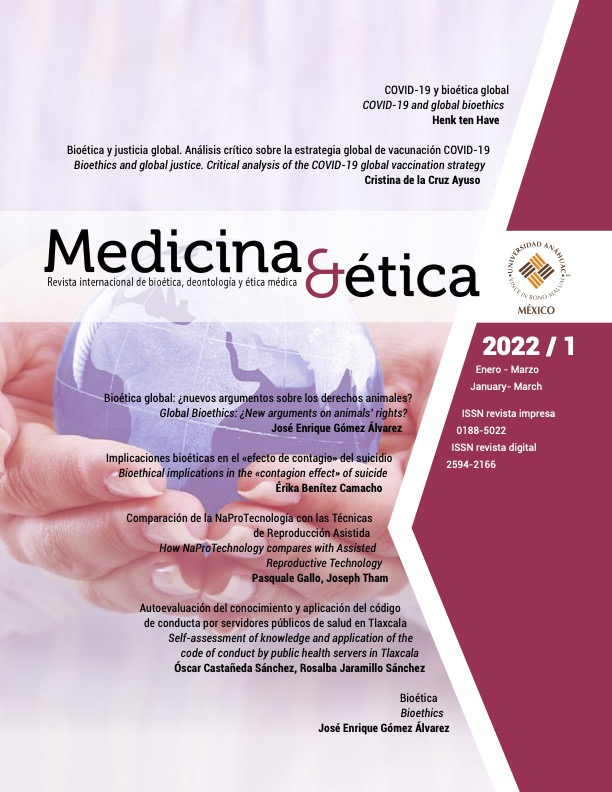Comparación de la NaProTecnología con las Técnicas de Reproducción Asistida
DOI:
https://doi.org/10.36105/mye.2022v33n1.05Palabras clave:
infertilidad, fertilización in vitro (fiv), métodos de concepción natural, síndrome de hiperestimulación ovárica (sho), dignidad humana, paternidad intencionalResumen
La progresiva medicalización de la infertilidad en las últimas tres décadas se corresponde con una creciente difusión de las Tecnologías de Reproducción Asistida (TRA), que han dejado en la sombra, casi por completo, otros enfoques más fisiológicos del tratamiento de la infertilidad, que tienen menos riesgos, son más económicos y, a la vez, igualmente efectivos. Este trabajo presenta un enfoque sistemático e integrado: la NaProTecnología (NPT), que tiene como objetivo optimizar las condiciones fisiológicas en cada ciclo menstrual, para permitir, de esta forma, una concepción por métodos naturales. Este método se postula como una mejor solución para el tratamiento de la infertilidad, desde un punto de vista que no sólo es más ético, sino que, además, es compatible con otros puntos de vistas religiosos, médicos, sociales, legales y ambientales. Los gobiernos deberían promover y financiar la NPT y, al mismo tiempo, las sociedades médicas y científicas deberían diseñar estudios para comparar de una manera justa la tasa de éxito, los costos y las complicaciones de la NPT en contraposición al método TRA tradicional.
Descargas
Referencias
Boivin J, Bunting L, Collins JA, Nygren KG. International estimates of infertility prevalence and treatment-seeking: Potential need and demand for infertility medi- cal care. Human Reproduction. 2007; 22(6): 1506-1512. https://doi.org/10.1093/humrep/dem046
Mascarenhas MN, Flaxman SR, Boerma T, Vanderpoel S, Stevens GA. Natio- nal, regional, and global trends in infertility prevalence since 1990: A systematic analysis of 277 health surveys. PLOS Medicine. 2012; 9(12): e1001356. https://doi.org/10.1371/journal.pmed.1001356
Stanford JB, Parnell AT, Boyle PC. Outcomes from treatment of infertility with natural procreative technology in an Irish general practice. Journal of the Ameri- can Board of Family Medicine: JABFM. 2008; 21(5): 375-384. https://doi.org/10.3122/jabfm.2008.05.070239
Cates W, Farley TM, Rowe PJ. Worldwide patterns of infertility: Is Africa diffe- rent? Lancet. 1985; 2: 596-598. https://doi.org/10.1016/S0140-6736(85)90594-X 5. Copperman AB, DeCherney AH. Turn, turn, turn. Fertil Steril. 2006; 85(1): 12-13. https://doi.org/10.1016/j.fertnstert.2005.07.1297
Lee P, Tham J. Catholic approaches to procreation and infertility. In: Joseph Tham, Alberto García Gómez, John Lunstroth eds. Multicultural & Interreligious Perspec- tives on the Ethics of Human Reproduction. Springer. 2021 (In press).
Genesis 1: 28, «Be fertile and multiply»; Genesis 2: 24, «That is why a man leaves his father and mother and is united to his wife, and they become one flesh». 8. Pope Paul VI, Pastoral Constitution on The Church in The Modern World, Gau- dium et Spes, December 7, 1965.
Wilson MA. The practice of natural family planning versus the use of artificial birth control: Family, sexual and moral issues. Catholic Social Science Review. 2002; 7. https://doi.org/10.5840/cssr2002718
Sgreccia E. Personalist Bioethics: Foundations and applications. 1st edition. Philadelphia: National Catholic Bioethics Center. 2012: 475-531
United States Conference of Catholic Bishops. Life-giving love in an age of technology. 2017. Available at: http://www.usccb.org/upload/lifegiving-love-age-te- chnology-2009.pdf
Tham J. Will to power: A critique of nihilistic tendencies in reproductive techno- logy. The New Bioethics. 2012; 18(2): 115-132. https://doi.org/10.1179/2050287713Z.00000000014
«Leading Bioethicist Supports Reproductive Cloning». BioEdge, no. 241; March 21, 2007.
«What Is Wrong with Cloning Anyway». BioEdge, no. 221; October 3, 2006. 15. «Let’s Legalise Human Cloning, Says Bioethicist». BioEdge, no. 259; August 1, 2007.
Assefi N, Levine BA. How in Vitro Fertilization (IVF) works. TED-Ed. 2015. Avai- lable at: https://www.youtube.com/watch?v=P27waC05Hdk
Hilbert SM, Gunderson S. Complications of assisted reproductive technology. Emergency Medicine Clinics of North America. 2019; 37(2): 239-249. https://doi.org/10.1016/j.emc.2019.01.005
Timmons D, Montrief T, Koyfman A, Long B. Ovarian Hyperstimulation Syndro- me: A review for emergency clinicians. Am J Emerg Med. 2019; 37(8): 1577-1584. https://doi.org/10.1016/j.ajem.2019.05.018
Marquardt E, Glenn ND, Clark K. My daddy’s name is donor: A new study of young adults conceived through sperm donation. 1st Edition, Broadway Publica- tions; 2010.
See Alternativefamilies.org which has information to help gays and lesbians to have children through different means.
Gallagher J. It is time to make three-person babies. BBC News, Sec. Health. November 30, 2016. Available at: http://www.bbc.com/news/health-38159777
Marquardt E. One parent or five: A global look at today’s new intentional fami- lies. The Institute for American Values. September 2011.
Jeynes HS. The effects of several of the most common family structures on the academic achievement of eighth graders. Marriage and Family Review. 2000; 30(1-2): 73-97. https://doi.org/10.1300/J002v30n01_06
Stack S, Ross Eshleman J. Marital status and happiness: A 17-Nation study. Journal of Marriage and the Family. 1998; 60(2): 527-536. https://doi.org/10.2307/353867
Dawson DA. Family structure and children’s health and well-being: Data from the 1988 national health interview survey on child health. Journal of Marriage and the Family. 1991; 53(3): 573-584. https://doi.org/10.2307/352734
Rohner RP, Veneziano RA. The Importance of father love: History and contem- porary evidence. Review of General Psychology. 2001; 5(4): 382-405. https://doi.org/10.1037/1089-2680.5.4.382
Putnam F. Ten year research update review: Child sexual abuse. Journal of the American Academy of Child and Adolescent Psychiatry. 2003; 42(3): 269-279. https://doi.org/10.1097/00004583-200303000-00006
Stiffman M. et al. Household composition and risk of fatal child maltreatment. Pediatrics. 2002; 109(4): 615-621. https://doi.org/10.1542/peds.109.4.615
Brown SL. The effect of union type on psychological well-being: Depression among cohabitors versus marrieds. Journal of Health and Social Behaviour. 2000; 41(3): 241-255. https://doi.org/10.2307/2676319
Horwitz AV, Raskin H. The relationship of cohabitation and mental health: A study of a young adult cohort. Journal of Marriage and the Family. 1998; 60(2): 505ff. https://doi.org/10.2307/353865
Environmental Protection Agency. Climate change indicators in the United Sta- tes. 2010. Available at: http://www.epa.gov/climatechange/indicators.html
Asin D. Covering Climate: What’s population got to do with It? Woodrow Wil- son International Center for Scholars Events, October 14, 2009. Available at: http:/ /www.wilsoncenter.org/event/covering-climate-whats-population-got-to-do-it
Richie C. What would an environmentally sustainable reproductive technology industry look lie. J Med Ethics. 2015; 41: 383-387. https://doi.org/10.1136/medethics-2013-101716
Scutti S. At least 8 million IVF babies born in 40 years since historic first. July 3, 2018. Available at: https://edition.cnn.com/2018/07/03/health/worldwide-ivf-ba- bies-born-study/index.html.
Murtaugh P, Schla M. Reproduction and the carbon legacies of individuals. Global Environ Change. 2009; 19: 14-20. https://doi.org/10.1016/j.gloenvcha.2008.10.007
Hilgers TW. Introduction to the Creighton Model System. In: Hilgers TW, ed. The medical and surgical practice of NaProTechnology. Ohama (NE): Pope Paul VI Institute Press. 2004: 43-56.
Check JH. Diagnosis and treatment of cervical mucus abnormalities. Clin Exp Obstet Gynecol. 2006; 33: 140-142.
The Practice Committee of the American Society for Reproductive Medicine. Use of Clomiphene in women. Fertil Steril. 2003; 80(5): 1302-1308. https://doi.org/10.1016/S0015-0282(03)01184-1
Pandian Z, Bhattacharya S, Vale S, Templeton A. In Vitro Fertilization for unex- plained infertility. Cochrane Database Syst Rev. 2005; 18(2): CD003357. https://doi.org/10.1002/14651858.CD003357.pub2
Johnson NP, Proctor M, Farquhar CM. Gaps in the evidence for fertility treat- ment, an analysis of the Cochrane menstrual disorders and subfertility group data- base. Hum Reprod. 2003; 18(5): 947-954. https://doi.org/10.1093/eshremonographs/2003.3.21
Kiani AK et al. Complications related to In Vitro Reproductive techniques sup- port the implementation of natural procreative technologies. Acta Biomed. 2020; 91(13-S): e2020018.
Niemitz EL, Feinberg AP. Epigenetics and assisted reproductive technology: A call for investigation. Am J Hum Genet. 2004; 74(4): 599-609. https://doi.org/10.1086/382897
Saint Peter’s Healthcare System. NaProTechnology, new hope in infertility. 2012. Available at: https://www.youtube.com/embed/ylaZGW028y8.
John Paul II. Address to UNESCO. June 2, 1980. Available at: http://inters.org/John-Paul-II-UNESCO-Culture
Congregation for the Doctrine of the Faith. Donum Vitae. Part II: Interventions upon human procreation. 1983.
Descargas
Publicado
Número
Sección
Licencia
Derechos de autor 2022 Universidad Anáhuac México

Esta obra está bajo una licencia internacional Creative Commons Atribución-NoComercial-CompartirIgual 4.0.
Medicina y Ética se distribuye bajo Licencia Creative Commons Atribución-NoComercial-CompartirIgual 4.0 Internacional.
El autor conserva los derechos patrimoniales sin restricciones y garantiza a la revista el derecho de ser la primera publicación del trabajo. El autor es libre de depositar la versión publicada en cualquier otro medio, como un repositorio institucional o en su propio sitio web.




























